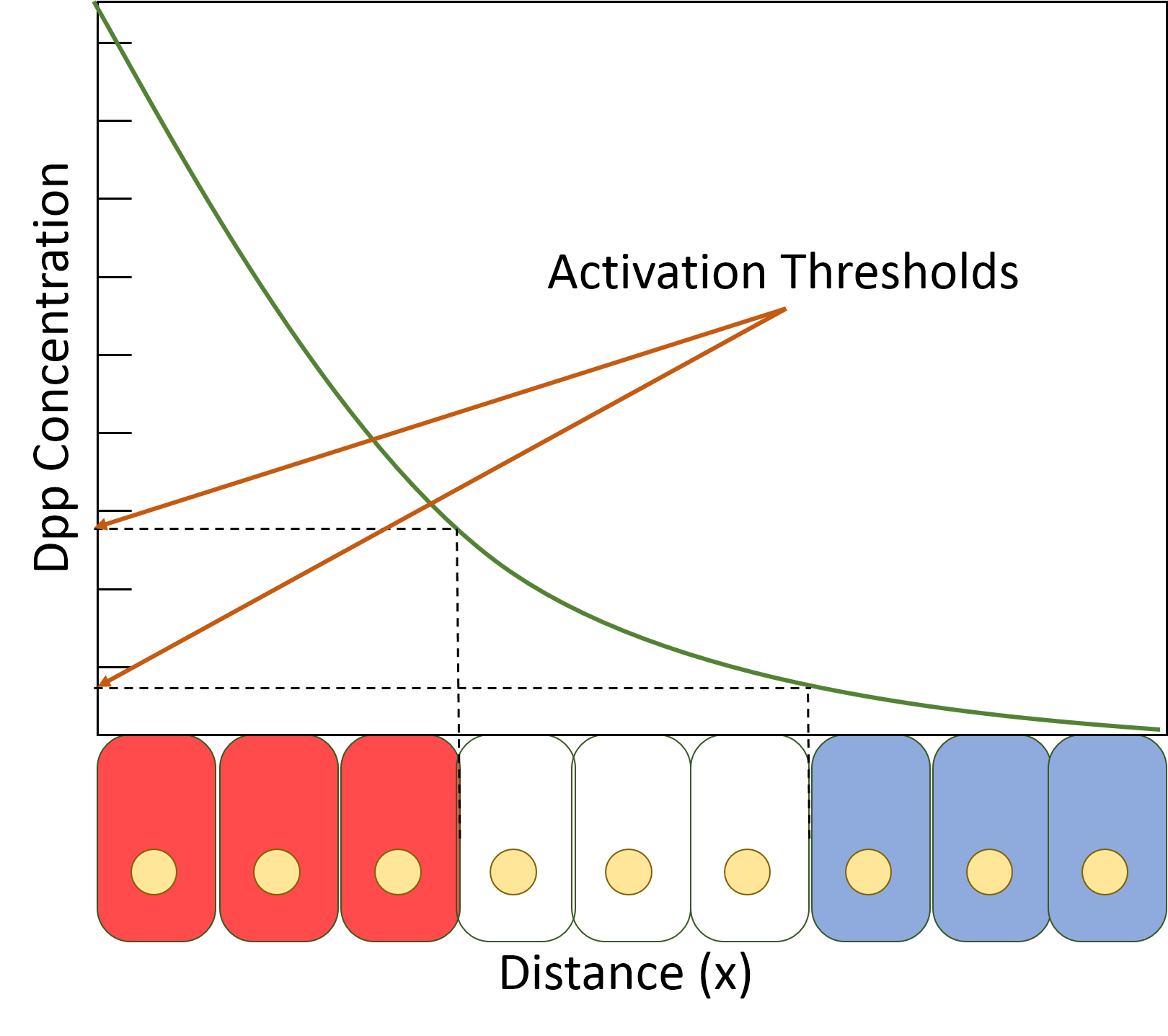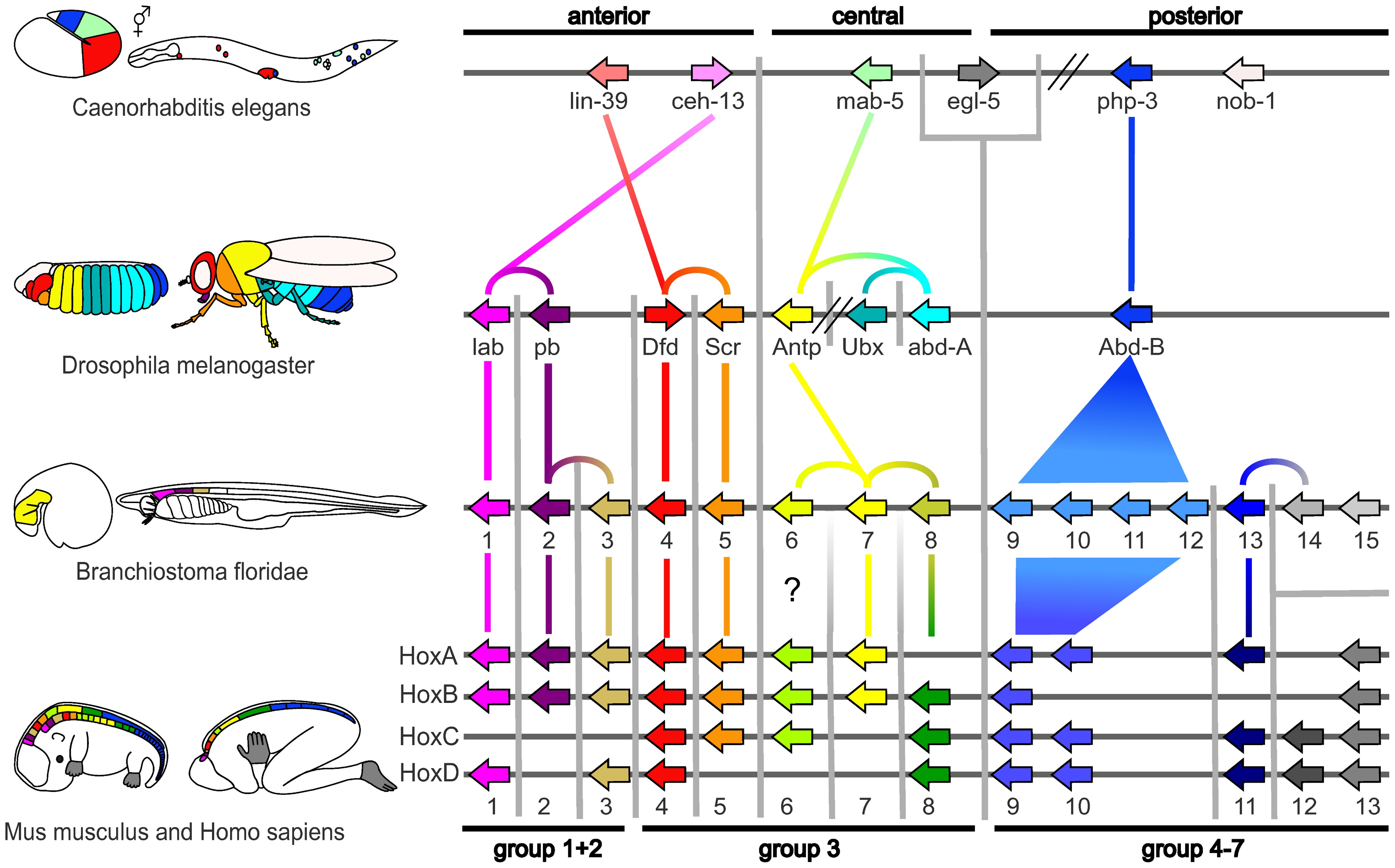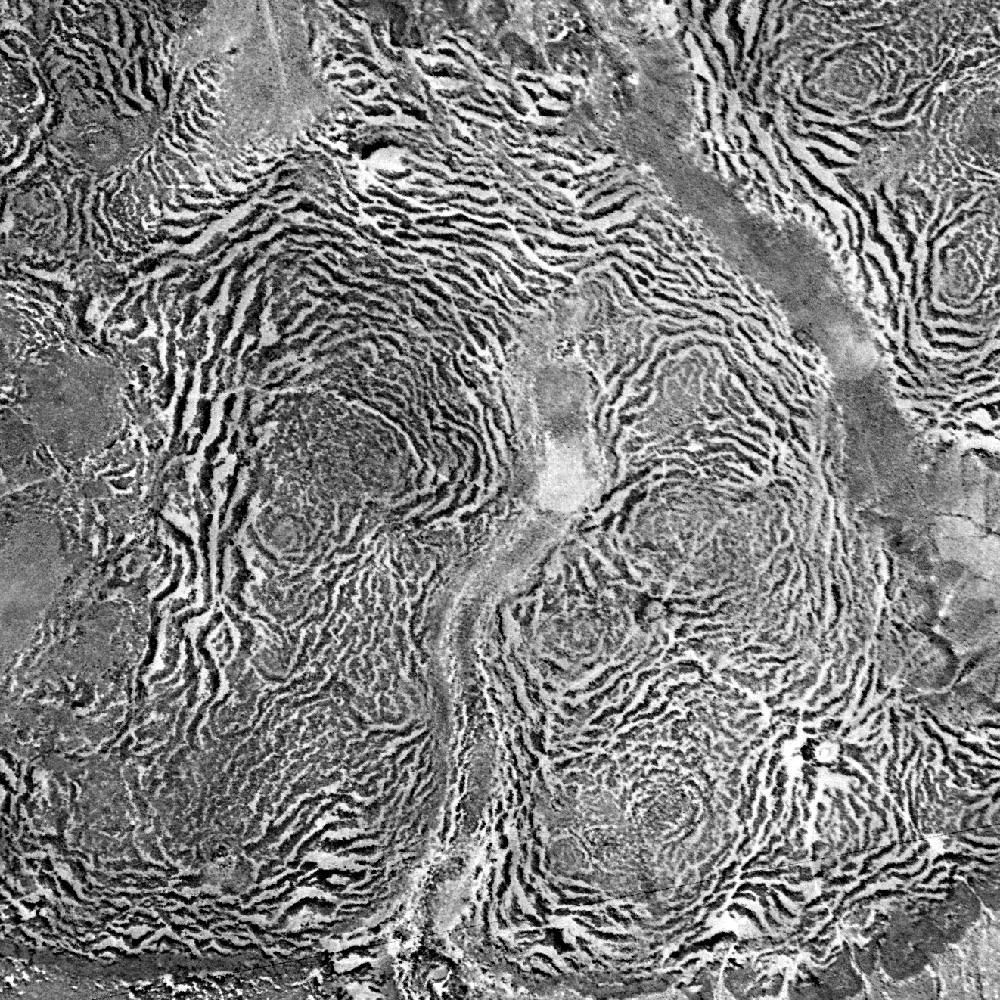|
Morphogen
A morphogen is a substance whose non-uniform distribution governs the pattern of tissue development in the process of morphogenesis or pattern formation, one of the core processes of developmental biology, establishing positions of the various specialized cell types within a tissue. More specifically, a morphogen is a signaling molecule that acts directly on cells to produce specific cellular responses depending on its local concentration. Typically, morphogens are produced by source cells and diffuse through surrounding tissues in an embryo during early development, such that concentration gradients are set up. These gradients drive the process of differentiation of unspecialised stem cells into different cell types, ultimately forming all the tissues and organs of the body. The control of morphogenesis is a central element in evolutionary developmental biology (evo-devo). History The term was coined by Alan Turing in the paper " The Chemical Basis of Morphogenesis", where h ... [...More Info...] [...Related Items...] OR: [Wikipedia] [Google] [Baidu] |
Morphogenesis
Morphogenesis (from the Greek ''morphê'' shape and ''genesis'' creation, literally "the generation of form") is the biological process that causes a cell, tissue or organism to develop its shape. It is one of three fundamental aspects of developmental biology along with the control of tissue growth and patterning of cellular differentiation. The process controls the organized spatial distribution of cells during the embryonic development of an organism. Morphogenesis can take place also in a mature organism, such as in the normal maintenance of tissue by stem cells or in regeneration of tissues after damage. Cancer is an example of highly abnormal and pathological tissue morphogenesis. Morphogenesis also describes the development of unicellular life forms that do not have an embryonic stage in their life cycle. Morphogenesis is essential for the evolution of new forms. Morphogenesis is a mechanical process involving forces that generate mechanical stress, strain, and m ... [...More Info...] [...Related Items...] OR: [Wikipedia] [Google] [Baidu] |
Decapentaplegic
Decapentaplegic (Dpp) is a key morphogen involved in the development of the fruit fly ''Drosophila melanogaster'' and is the first validated secreted morphogen. It is known to be necessary for the correct patterning and development of the early ''Drosophila'' embryo and the fifteen imaginal discs, which are tissues that will become limbs and other organs and structures in the adult fly. It has also been suggested that Dpp plays a role in regulating the growth and size of tissues. Flies with mutations in decapentaplegic fail to form these structures correctly, hence the name (''decapenta''-, fifteen, -''plegic'', paralysis). Dpp is the Drosophila homolog of the vertebrate bone morphogenetic proteins (BMPs), which are members of the TGF-β superfamily, a class of proteins that are often associated with their own specific signaling pathway. Studies of Dpp in Drosophila have led to greater understanding of the function and importance of their homologs in vertebrates like humans. Fu ... [...More Info...] [...Related Items...] OR: [Wikipedia] [Google] [Baidu] |
French Flag Model
The French flag model is a conceptual definition of a morphogen, described by Lewis Wolpert in the 1960s. A morphogen is defined as a signaling molecule that acts directly on cells (not through serial induction) to produce specific cellular responses dependent on morphogen concentration. During early development, morphogen gradients generate different cell types in distinct spatial order. French flag patterning is often found in combination with others: vertebrate limb development is one of the many phenotypes exhibiting Turing overlapped with a complementary pattern (in this case Turing pattern). Overview In the French flag model, the French flag is used to represent the effect of a morphogen on cell differentiation: a morphogen affects cell states based on concentration, these states are represented by the different colors of the French flag: high concentrations activate a "blue" gene, lower concentrations activate a "white" gene, with "red" serving as the default state in ... [...More Info...] [...Related Items...] OR: [Wikipedia] [Google] [Baidu] |
Bicoid
Homeotic protein bicoid is encoded by the ''bcd'' maternal effect gene in ''Drosophilia''. Homeotic protein bicoid concentration gradient patterns the anterior-posterior (A-P) axis during ''Drosophila'' embryogenesis. Bicoid was the first protein demonstrated to act as a morphogen. Although bicoid is important for the development of ''Drosophila'' and other higher dipterans, it is absent from most other insects, where its role is accomplished by other genes. Role in axial patterning ''Bicoid'' mRNA is actively localized to the anterior of the fruit fly egg during oogenesis along microtubules by the motor protein dynein, and retained there through association with cortical actin. Translation of ''bicoid'' is regulated by its 3′ UTR and begins after egg deposition. Diffusion and convection within the syncytium produce an exponential gradient of Bicoid protein within roughly one hour, after which Bicoid nuclear concentrations remain approximately constant through cellularizat ... [...More Info...] [...Related Items...] OR: [Wikipedia] [Google] [Baidu] |
Natural Patterns
Patterns in nature are visible regularities of form found in the natural world. These patterns recur in different contexts and can sometimes be modelled mathematically. Natural patterns include symmetries, trees, spirals, meanders, waves, foams, tessellations, cracks and stripes. Early Greek philosophers studied pattern, with Plato, Pythagoras and Empedocles attempting to explain order in nature. The modern understanding of visible patterns developed gradually over time. In the 19th century, the Belgian physicist Joseph Plateau examined soap films, leading him to formulate the concept of a minimal surface. The German biologist and artist Ernst Haeckel painted hundreds of marine organisms to emphasise their symmetry. Scottish biologist D'Arcy Thompson pioneered the study of growth patterns in both plants and animals, showing that simple equations could explain spiral growth. In the 20th century, the British mathematician Alan Turing predicted mechanisms of morphogenesis whic ... [...More Info...] [...Related Items...] OR: [Wikipedia] [Google] [Baidu] |
Developmental Biology
Developmental biology is the study of the process by which animals and plants grow and develop. Developmental biology also encompasses the biology of regeneration, asexual reproduction, metamorphosis, and the growth and differentiation of stem cells in the adult organism. Perspectives The main processes involved in the embryonic development of animals are: tissue patterning (via regional specification and patterned cell differentiation); tissue growth; and tissue morphogenesis. * Regional specification refers to the processes that create the spatial patterns in a ball or sheet of initially similar cells. This generally involves the action of cytoplasmic determinants, located within parts of the fertilized egg, and of inductive signals emitted from signaling centers in the embryo. The early stages of regional specification do not generate functional differentiated cells, but cell populations committed to developing to a specific region or part of the organism. These are ... [...More Info...] [...Related Items...] OR: [Wikipedia] [Google] [Baidu] |
Alan Turing
Alan Mathison Turing (; 23 June 1912 – 7 June 1954) was an English mathematician, computer scientist, logician, cryptanalyst, philosopher, and theoretical biologist. Turing was highly influential in the development of theoretical computer science, providing a formalisation of the concepts of algorithm and computation with the Turing machine, which can be considered a model of a general-purpose computer. He is widely considered to be the father of theoretical computer science and artificial intelligence. Born in Maida Vale, London, Turing was raised in southern England. He graduated at King's College, Cambridge, with a degree in mathematics. Whilst he was a fellow at Cambridge, he published a proof demonstrating that some purely mathematical yes–no questions can never be answered by computation and defined a Turing machine, and went on to prove that the halting problem for Turing machines is undecidable. In 1938, he obtained his PhD from the Department of ... [...More Info...] [...Related Items...] OR: [Wikipedia] [Google] [Baidu] |
Drosophila Melanogaster
''Drosophila melanogaster'' is a species of fly (the taxonomic order Diptera) in the family Drosophilidae. The species is often referred to as the fruit fly or lesser fruit fly, or less commonly the " vinegar fly" or " pomace fly". Starting with Charles W. Woodworth's 1901 proposal of the use of this species as a model organism, ''D. melanogaster'' continues to be widely used for biological research in genetics, physiology, microbial pathogenesis, and life history evolution. As of 2017, five Nobel Prizes have been awarded to drosophilists for their work using the insect. ''D. melanogaster'' is typically used in research owing to its rapid life cycle, relatively simple genetics with only four pairs of chromosomes, and large number of offspring per generation. It was originally an African species, with all non-African lineages having a common origin. Its geographic range includes all continents, including islands. ''D. melanogaster'' is a common pest in homes, restaurants, ... [...More Info...] [...Related Items...] OR: [Wikipedia] [Google] [Baidu] |
Evolutionary Developmental Biology
Evolutionary developmental biology (informally, evo-devo) is a field of biological research that compares the developmental processes of different organisms to infer how developmental processes evolved. The field grew from 19th-century beginnings, where embryology faced a mystery: zoologists did not know how embryonic development was controlled at the molecular level. Charles Darwin noted that having similar embryos implied common ancestry, but little progress was made until the 1970s. Then, recombinant DNA technology at last brought embryology together with molecular genetics. A key early discovery was of homeotic genes that regulate development in a wide range of eukaryotes. The field is composed of multiple core evolutionary concepts. One is deep homology, the finding that dissimilar organs such as the eyes of insects, vertebrates and cephalopod molluscs, long thought to have evolved separately, are controlled by similar genes such as ''pax-6'', from the evo-devo gene ... [...More Info...] [...Related Items...] OR: [Wikipedia] [Google] [Baidu] |
Pattern Formation
The science of pattern formation deals with the visible, (statistically) orderly outcomes of self-organization and the common principles behind similar patterns in nature. In developmental biology, pattern formation refers to the generation of complex organizations of cell fates in space and time. The role of genes in pattern formation is an aspect of morphogenesis, the creation of diverse anatomies from similar genes, now being explored in the science of evolutionary developmental biology or evo-devo. The mechanisms involved are well seen in the anterior-posterior patterning of embryos from the model organism ''Drosophila melanogaster'' (a fruit fly), one of the first organisms to have its morphogenesis studied, and in the eyespots of butterflies, whose development is a variant of the standard (fruit fly) mechanism. Patterns in nature Examples of pattern formation can be found in biology, physics, and science, and can readily be simulated with computer graphics, as desc ... [...More Info...] [...Related Items...] OR: [Wikipedia] [Google] [Baidu] |
Lewis Wolpert
Lewis Wolpert (19 October 1929 – 28 January 2021) was a South African-born British developmental biologist, author, and broadcaster. Wolpert was best known for his French flag model of embryonic development, where he used the French flag as a visual aid to explain how embryonic cells interpret genetic code for expressing characteristics of living organisms and explaining how signalling between cells early in morphogenesis could be used to inform cells with the same genetic regulatory network of their position and role. He was also an author of several science books including ''Triumph of the Embryo'' (1991), ''Malignant Sadness'' (1999), ''The Evolutionary Origins of Belief'' (2006), and ''How We Live And Why We Die: The Secret Lives of Cells'' (2009). Early life Wolpert was born on 19 October 1929, in Johannesburg to Sarah (née Suzman) and William Wolpert in a South African Jewish family of Lithuanian Jewish origin. His father was a bookshop manager and newsagent. His ... [...More Info...] [...Related Items...] OR: [Wikipedia] [Google] [Baidu] |
Peter Lawrence (biologist)
Peter Anthony Lawrence (born 23 June 1941) is a British developmental biologist at the Laboratory of Molecular Biology and the Zoology Department of the University of Cambridge. He was a staff scientist of the Medical Research Council from 1969 to 2006. Education Lawrence was educated at Wennington School in Wetherby, and then at St Catharine's College, Cambridge on a Harkness Fellowship; he gained his doctorate as a student of Vincent Wigglesworth for work on ''Oncopeltus fasciatus'' (milkweed bug) Career and research Lawrence's main discoveries lie in trying to understand what type of information is required to shape an animal and generate a pattern (such as on a butterfly wing or a fingerprint). He is the principal advocate of the idea that cells in a gradient of a morphogen develop according to their local concentration of the morphogen and that this mechanism is used to generate patterns of cells. Together with Ginés Morata, he has helped establish the compartment the ... [...More Info...] [...Related Items...] OR: [Wikipedia] [Google] [Baidu] |









